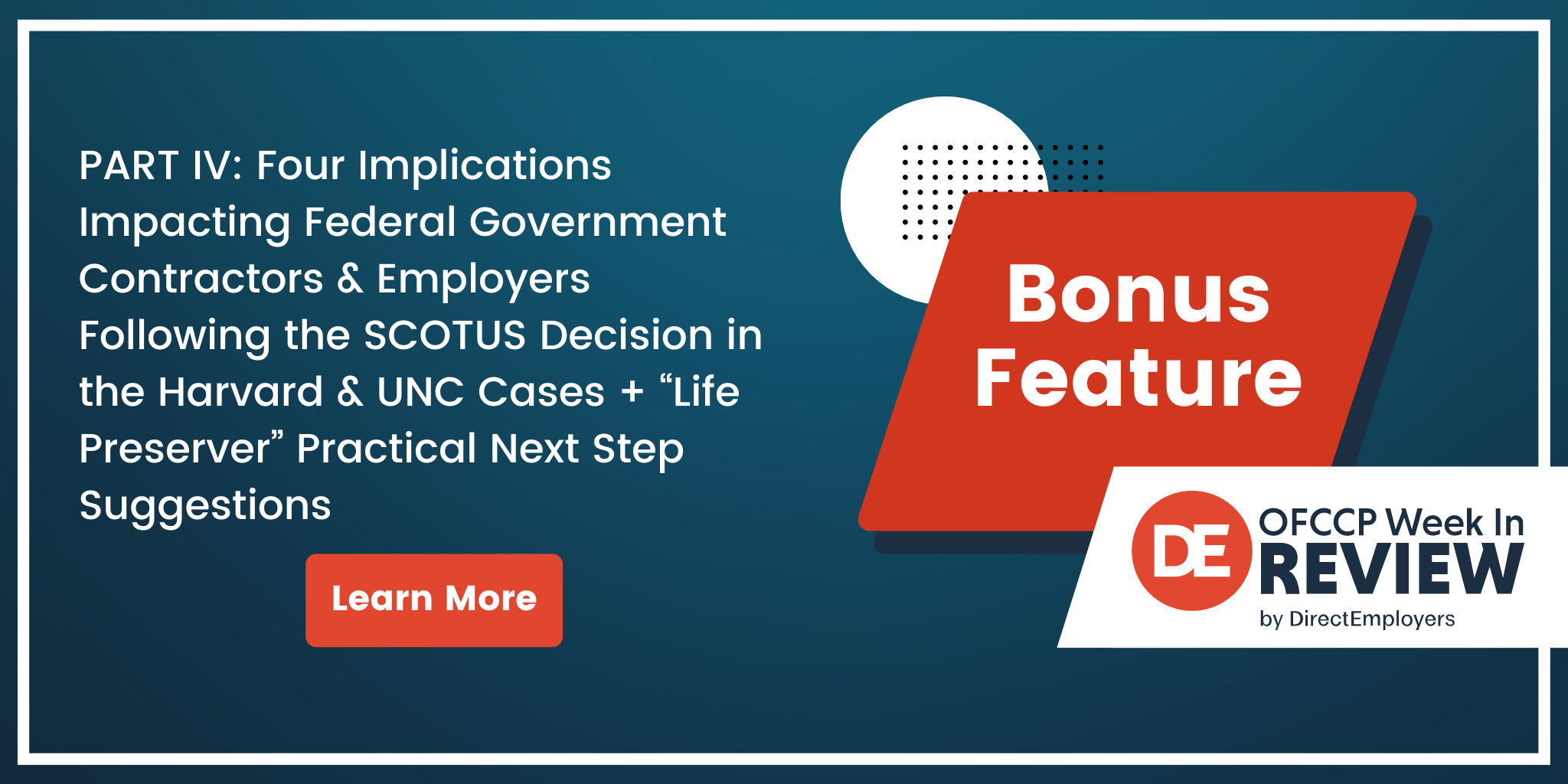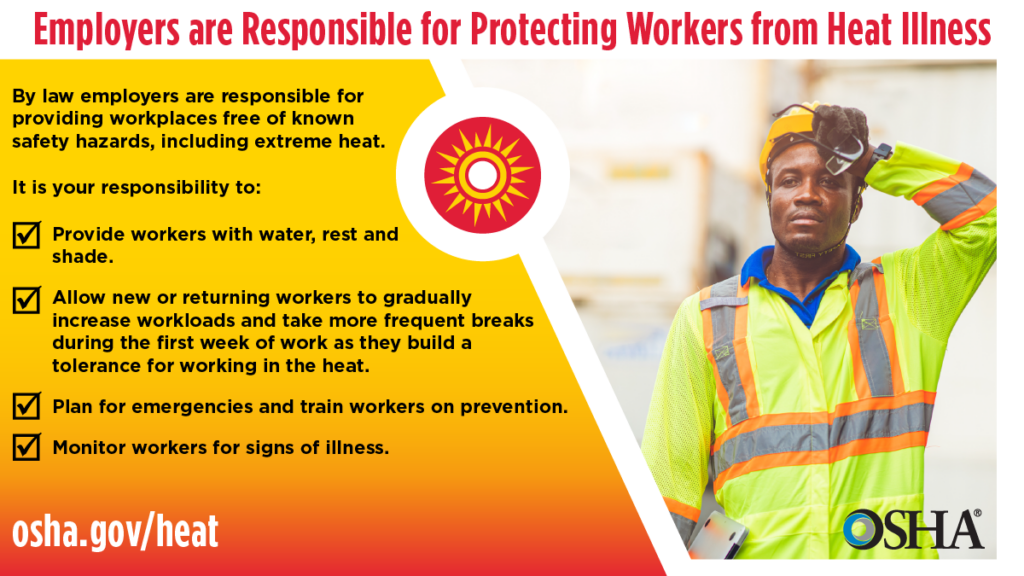
- Four Implications Impacting Federal Government Contractors & Employers Following the SCOTUS Decision in the Harvard & UNC Cases + “Life Preserver” Practical Next Step Suggestions
- USCIS Published Notice Introducing Revised I-9 Form
- U.S. EEOC Updated Technical Assistance Document on Visual Disabilities
- U.S. DOL’s OSHA Issued First-Ever Hazard Alert for Heat
- OFCCP Updated Its Affirmative Action FAQ Section to Address Recent SCOTUS University Admissions Case Decisions
- In Brief
- Looking Ahead: Upcoming Date Reminders
Monday, July 31, 2023: Part IV (Finale): Four Implications Impacting Federal Government Contractors & Employers Following the SCOTUS Decision in the Harvard & UNC Cases + “Life Preserver” Practical Next Step Suggestions

The original Blog discussing the SCOTUS’ six Opinions in the Harvard/UNC case decision is here.
PART I discussing the “Pipeline Problem” and suggested “Life Preserver” Solutions is here.
PART II discussing ”Goals Are Not Unlawful Quotas” is here.
PART III discussing “Doing Right the Right Way: The Renewed Commitment To Hiring African Americans Is Not A “Greenlight” to Unlawfully Discriminate Against Other Protected Groups” is here.
Today’s Blog discusses “How to Lawfully Engage in Race-Based Employment Decisions If You Choose to Do So.”
PUNCHLINE: Let me start with the legal conclusion and then work backward to the underlying legal decisions which drive that conclusion and related conclusions:
An employer or federal government contractor may now undertake a preference in employment “because of” race (or national origin or sex) only to remedy unlawful employment discrimination the employer has committed and which discrimination is still within an applicable law’s statute of limitations period.
I believe this to be true for both public sector and private sector employees bound by the following various federal anti-discrimination laws…
Tuesday, July 25, 2023: USCIS Published Notice Introducing Revised I-9 Form
Agency Announced Revised Form Last Week

Our story last week also explained that the DHS announced a Final Rule, also published in the Federal Register on Tuesday, July 25, that recognized the end of temporary COVID-19 “flexibilities” as of July 31 (see our story back in March here). That same Final Rule also provided DHS the authority to authorize optional alternatives for employers to examine Form I-9 documentation. The Final Rule will become legally effective on August 1, 2023. Also on Tuesday, July 25, the DHS published an accompanying document in the Federal Register describing and authorizing employers enrolled in E-Verify the option to remotely examine their employees’ identity and employment authorization documents under a DHS-authorized alternative procedure.
WEBINAR ALERT
Register today for a webinar on August 23, 2023 at 2:00 pm ET for a review of the form. Learn about revised Form I-9 requirements, step-by-step instructions on how to complete each section, acceptable documents, retention, and storage – straight from the U.S. Citizenship and Immigration Service Department of Homeland Security!
Wednesday, July 26, 2023: U.S. EEOC Updated Technical Assistance Document on Visual Disabilities
Updated Document Also Discusses AI & Related Accommodations

Questions 16 and 17 of the Q&A document cover how using artificial intelligence (AI) and algorithms to make employment decisions might impact individuals with visual disabilities. Question 16 notes that AI or algorithms may screen out workers with disabilities, even when they may be able to perform the job with a reasonable accommodation. For example, a worker may have a visual disability that reduces the accuracy of an AI assessment used to evaluate the applicant or employee. In such cases, the employer must provide a reasonable accommodation, such as an alternative testing format, which would provide a more accurate assessment of the applicant’s or employee’s ability to perform the position, absent undue hardship, the EEOC stated.
In addition, the response to Question 17 suggests that:
“Employers may, as a promising practice, take steps to provide information about how the technology evaluates applicants or employees (thus alerting those with visual disabilities that the technology might not accurately assess their qualifications) and provide instructions for how to seek a reasonable accommodation. Employers should appropriately respond to requests for reasonable accommodations related to the employer’s use of algorithms or AI as decision-making tools.”
The EEOC’s Response to its Question 17 is another reminder of the EEOC’s “Best Practices” suggestion to employers to ask vendors what AI, if any, is embedded in Human Resources software tools. The EEOC’s belief is that if employers become knowledgeable that their HR software tools contain AI functionality, that well intentioned employers might then examine those tools more carefully to ensure they do not unlawfully screen out Protected Group members, including applicants and employees with disabilities, from job and work opportunities.
Thursday, July 27, 2023: U.S. DOL’s OSHA Issued First-Ever Hazard Alert for Heat
OSHA will step-up inspections of construction and agriculture worker sites
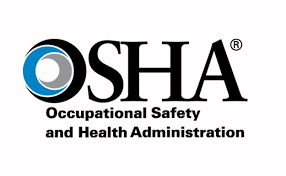
OSHA currently uses OSHA’s “General Duty Clause” (section 5(a)1 of the Occupational Safety and Health Act) to prosecute employers for failing to furnish employees with a workplace that is free from recognized hazards that “are causing or likely to cause death or serious harm.” The effect of OSHA’s Hazard Alert is to make known to employers that OSHA considers heat exhaustion and heat-induced death to be a “recognized hazard.”
As scientists declared July the world’s hottest month on record, the White House’s “Fact Sheet” announcing the Hazard Alert also noted that OSHA will ramp up enforcement of heat-safety violations, increasing inspections in high-risk industries like construction and agriculture. At the same time, OSHA continues to develop a national standard for workplace heat-safety rules. Although the agency published an “Advance Notice of Proposed Rulemaking” (“ANPR”) on October 27, 2021, it has yet to issue a “Notice of Proposed Rulemaking” (“NPR”) as to this standard.
“Historically high temperatures impact everyone and put our nation’s workers at high risk,” said Acting Secretary of Labor Julie Su, in a press release. “A workplace heat standard has long been a top priority for the Department of Labor, but rulemaking takes time and working people need help now,” she added.
OSHA’s 21-month delay (and counting) in proceeding from an ANPR to an NPR is another sign of the U.S. DOL’s slowing productivity. Before the COVID-19 pandemic, federal agencies like OSHA typically published NPRs within several months of publishing their ANPR. The Government Accounting Office earlier this month reported that the headquarters offices of federal agencies, like USDOL and OSHA (although not mentioned by name), are only 25% occupied by onsite employees amid other reports that federal unions continue to oppose return to work orders from many federal agencies.
Thursday, July 27, 2023: OFCCP Updated Its Affirmative Action FAQ Section to Address Recent SCOTUS University Admissions Case Decisions

“Are the affirmative action obligations OFCCP enforces similar to the affirmative action steps taken by some educational institutions to increase the racial diversity of their student bodies?”
On Thursday, OFCCP updated its existing answer (set out below for comparison) to now read as follows:
“No. OFCCP enforces nondiscrimination and affirmative action obligations to ensure equal opportunity in the federal contractor workforce, while some post-secondary educational institutions have implemented a wholly distinct concept of affirmative action that permitted the use of race to be weighed as one factor among many in admissions processes. Further, the Supreme Court’s decision in Students for Fair Admissions applies only to higher education admissions programs and does not address the employment context. See Students for Fair Admissions, Inc. v. President and Fellows of Harvard College, No. 20-1199, slip op. at 2-5, 23-30 (U.S. June 29, 2023). There continue to be lawful and appropriate ways to foster equitable and inclusive work environments and recruit qualified workers of all backgrounds. OFCCP’s affirmative action requirements enable employers to reduce the risk of discrimination in their workforces and recruit and retain diverse talent.”
Previously, OFCCP had answered that question as follows:
“No. While OFCCP seeks to increase the diversity of the federal contractor workforce through the variety of affirmative action obligations described above, the obligations it enforces are wholly distinct from the concept of affirmative action as implemented by some post-secondary educational institutions in their admissions processes. In contrast to the affirmative action implemented by many post-secondary institutions, OFCCP does not permit the use of race to be weighed as one factor among many in an individual’s application when rendering hiring, employment, or personnel decisions, as racial preferences of any kind are prohibited under the authorities administered by OFCCP. See 41 CFR 60-1.4(a), 60-300.5(a) and 60-741.5(a). OFCCP, therefore, does not permit the use of race as a factor in contractors’ employment practices to achieve diversity in the workforce, either by using race as one factor among many to achieve a “critical mass” of representation for underrepresented minorities or through direct numerical quotas or set-asides. See, e.g., Fisher v. University of Texas, 136 S. Ct. 2198, 2214-15 (2016); Grutter v. Bollinger, 539 U.S. 306, 330-31 (2003); Regents of University of California v. Bakke, 438 U.S. 265, 324 (1978). OFCCP’s affirmative action regulations expressly forbid the use of quotas or set asides, provide no legal justification for a contractor to extend preferences on the basis of a protected status, and do not supersede merit selection principles. See 41 CFR 2.16(e).”
As WIR readers are likely aware, John Fox has frequently made the above points (and expanded on them) in multiple Bonus Blogs and other stories, including here and here. Moreover, readers should not miss John’s Four-Part Series discussing the implications for employers of the SCOTUS case decision resolving the Harvard and UNC cases.
- PART I, discussing the “Pipeline Problem” and suggested “Life Preserver” Solutions, is here.
- PART II, discussing ”Goals Are Not Unlawful Quotas,” is here.
- PART III, discussing “Doing Right the Right Way: The Renewed Commitment To Hiring African Americans Is Not A ‘Greenlight’ to Unlawfully Discriminate Against Other Protected Groups,” is here.
- PART IV, discussing “How to Lawfully Engage in Race-Based Employment Decisions If You Choose to Do So,” is included with today’s WIR edition.
In Brief
Tuesday, July 25, 2023: President Signed Law Requiring Agencies to Provide 100-Word Plain Language Summary of Proposed Rule Notices

The U.S. Senate passed the bill by unanimous consent on June 22 and the House of Representatives unanimously passed the bill on July 17. The full text of the measure is available here.
This Resolution seems redundant in that the federal agencies already precede their proposed Rules with a summary of the Rule’s contents, typically occupying between 400-500 words. If there was unhappiness with the content of the existing Summaries, the President should have just issued an Executive Order directing the federal Executive Branch agencies to do a better job of writing their proposed Rule Summaries. It looks like many Members of Congress are already preparing for the November 2024 Congressional elections by creating talking points for their re-election speeches bullet-pointing what they have accomplished for the voters.
Thursday, July 27, 2023: USDOL OLMS Announced Finalized Changes to Revise Union Persuader Reports (Form LM-10) to “Out” Federal Contractors
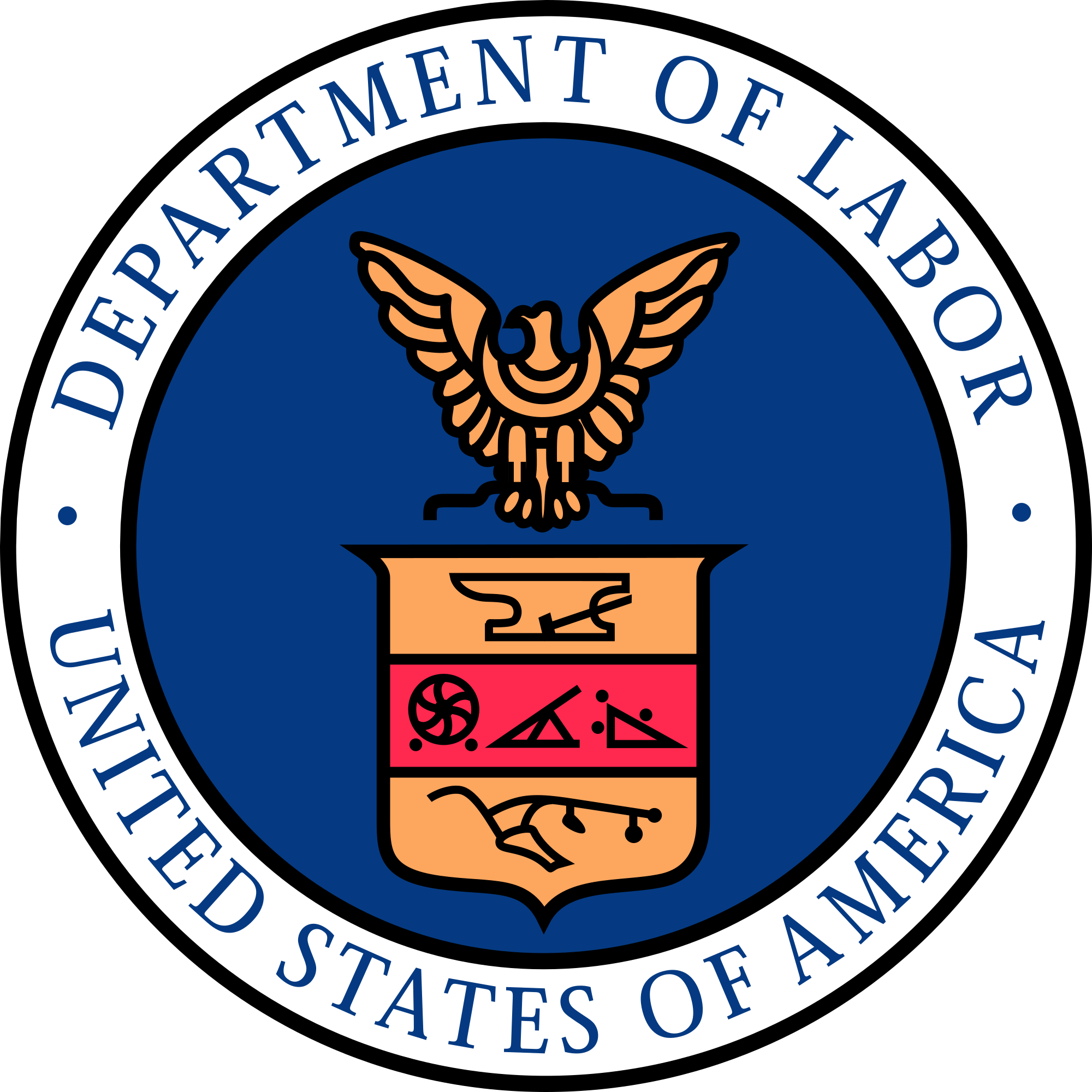
The revised form will be the required form for all Form LM-10s filed on or after Monday, August 28, 2023. OLMS stated in an accompanying press release that the Revised LM-10 Forms will be available on the OLMS Electronic Filing System by the required date. On Friday, OLMS Director Jeffrey Freund also posted a corresponding blog post. In addition, OLMS posted a “Fact Sheet” on the revisions.
The Labor-Management Reporting and Disclosure Act of 1959 (LMRDA) requires employers to file a Form LM-10 with the OLMS to disclose certain payments, expenditures, agreements, and arrangements. Among other information, employers must file reports covering agreements with consultants – and other payments and expenditures – designed to persuade employees concerning their organizing and collective bargaining rights or to surveil the activities of employees and unions involved in a labor dispute with the employers. The revision announced on Thursday does not change which companies must file LM-10 forms or when or how often they must file. For additional background on this form and the previous notice-and-comment process on the revisions, see our earlier stories here and here.
Friday, July 28, 2023: Republican Senators Announced Proposed CRA Resolution of Disapproval on OFCCP’s Religious Exemption Rule It Issued in March
Resolution Introduced in Senate Last Month; OFCCP Rule Took Effect in March
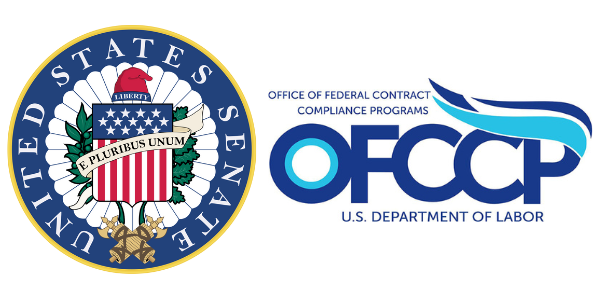
Senator Lankford introduced the Resolution – S.J.Res.36 – on Thursday, June 22, 2023, but he did not issue his press release announcing it until this past Friday. The Resolution has 24 co-sponsors, all Republicans. In addition to expressing disapproval of the OFCCP’s Final Rule, the Resolution provides that the Rule would have no force or effect.
Looking Ahead:
Upcoming Date Reminders
June 2023: OFCCP’s current target date (now overdue) for its Final Rule on Pre-Enforcement Notice & Conciliation Procedures (RIN: 1250-AA14)
June 2023: U.S. DOL WHD’s current target date (now overdue) to publish its Final Rule on Nondisplacement of Qualified Workers Under Service Contracts (RIN: 1235-AA42)
June 2023: U.S. DOL WHD’s current target date (now overdue) for its Final Rule on Updating the Davis-Bacon and Related Acts Regulations (RIN: 1235-AA40)
June 2023: U.S. OSHA’s current target date (now overdue) to publish its Final Rule on Occupational Exposure to COVID-19 in Healthcare Settings (RIN: 1218-AD36)
NEW Tuesday, August 1, 2023: 2023 VETS-4212 reporting cycle expected to begin and last through Saturday, September 30. (No updates, however, on the VETS-4212 website yet.)
Tuesday, August 1, 2023: Deadline for public comments on FAR Council’s Interim Rule Banning TikTok on Government Contractor Devices
Friday, August 11, 2023: Comments due on the EEOC’s proposal to extend – without change – the Information Collection Requirement (“ICR”) for the ADEA/OWBPA third-party waiver and disclosure requirements
Friday, August 11, 2023: Deadline for Presenter Proposal Submissions for DEAMcon 2024
NEW Monday, August 28, 2023: Employers required to file Form LM-10 (union “persuader reports”) must begin using revised version of the form
August 2023: U.S. DOL WHD’s current target date for its Final Rule on Employee or Independent Contractor Classification Under the Fair Labor Standards Act (RIN: 1235-AA43)
August 2023: U.S. DOL WHD’s current target date for its Notice of Proposed Rulemaking on Defining and Delimiting the Exemptions for Executive, Administrative, Professional, Outside Sales and Computer Employees (RIN: 1235-AA39) (The WHD submitted this proposal to the OMB on July 12, 2023)
August 2023: U.S. NLRB’s target date for its Direct Final Rule on Quickie Election Procedures (RIN: 3142-AA18)
August 2023: U.S. NLRB’s current target date for its Final Rule on Standard for Determining Joint-Employer Status (under the NLRA) (RIN: 3142-AA21)
August 2023: U.S. NLRB’s current target date for its Final Election Protection Rule (RIN: 3142-AA22)
August 2023: U.S. DOL’s OASAM’s current target date to publish Proposed Rule on “Revision of the Regulations Implementing Section 188 of the Workforce Innovation and Opportunity Act (WIOA) to Clarify Nondiscrimination and Equal Opportunity Requirements and Obligations Related to Sex” (RIN: 1291-AA44)
Tuesday, September 19, 2023: Comments due on the Office of Personnel Management’s Proposed Rule – “Recruitment and Selection Through Competitive Examination, and Employment in the Excepted Service (Rule of Many)”
December 2023: OFCCP’s current target date for its Notice of Proposed Rulemaking to “Modernize” Supply & Service Contractor Regulations (RIN: 1250-AA13)
December 2023: OFCCP’s current target date for its Final Rule on “Technical Amendments” to Update Jurisdictional Thresholds & Remove Gender Assumptive Pronouns (RIN: 1250-AA16)
December 29, 2023: Statutory deadline for EEOC regulations to enforce the Pregnant Workers Fairness Act
Monday, January 1, 2024: U.S. DOL OSHA’s Final Rule Requiring Covered High-Hazard Industry Employers to Electronically Submit Injury & Illness Records Takes Effect
Wednesday, April 3 – Friday, April 5, 2024: DEAMcon24 New Orleans
June 2024: OFCCP’s current target date for its Notice of Proposed Rulemaking to Require Reporting of Subcontractors (RIN: 1250-AA15)
THIS COLUMN IS MEANT TO ASSIST IN A GENERAL UNDERSTANDING OF THE CURRENT LAW AND PRACTICE RELATING TO OFCCP. IT IS NOT TO BE REGARDED AS LEGAL ADVICE. COMPANIES OR INDIVIDUALS WITH PARTICULAR QUESTIONS SHOULD SEEK ADVICE OF COUNSEL.
SUBSCRIBE.
Compliance Alerts
Compliance Tips
Week In Review (WIR)
Subscribe to receive alerts, news and updates on all things related to OFCCP compliance as it applies to federal contractors.
OFCCP Compliance Text Alerts
Get OFCCP compliance alerts on your cell phone. Text the word compliance to 55678 and confirm your subscription. Provider message and data rates may apply.

